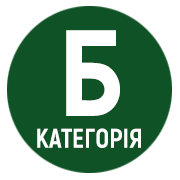ІMITATION IN THE SYSTEM OF LOGICAL AND SEMANTIC CONNECTIONS
DOI:
https://doi.org/10.32782/psy-2024-3-4Keywords:
thinking, meaning, imitation, informational uncertainty, logical and semantic connection, semantic reconstructionAbstract
In this article, the uneven nature of the thought process is being analyzed. In particular, the specifics of semantic imitation are studied, its absolute indicators and dynamic properties are determined, and its impact on the formation of overall meaning is recorded. The diagnostic tool used here is the «Methodology of text gaps». The research involved 104 young people. The low absolute rate of semantic imitation was discovered (4% of logical and semantic connections of imitative content). Semantic imitation was used by the 40% of the participants. Systematic use of imitation is found in the 6% of the participants. The downward trend in imitation use was noticed in the psychodynamic aspects, however, this trend doesn’t have any statistical significance. At the same time, there is a very clear tendency towards using imitative connections with the previous sentence rather than the next one (p≤0.01). Therewith, imitation has an inverse moderate correlation with logicality (-0.3) and effusivity, or semantic crystallization (-0.4). Based on the fact that imitation has a direct moderate correlation with semantic gaps (0.35), we assume that it serves as an alternative way out of semantic dead-ends. However, the determination coefficient (R2) between them varies at the level of 12% of variables, which is a minor indicator. It becomes more noticeable that imitation forms 43% of the overall semantic coefficient. It should be noted that the level of correlation between imitation and the semantic coefficient is strong and inverse (-0.65). This clearly contradicts the low absolute rate of semantic imitability. It has been suggested that imitation phenomenon is naturally integrated into the thinking process, it is complied with the dynamics of the individual trajectory in developing logical and semantic connections.
References
Мазяр О. «Методика текстуальних розривів» як метод вивчення процесуальних характеристик мислення. Функціонування творчого мислення в умовах інформаційної невизначеності : матеріали ХХІІІ Всеукраїнської науково-практичної конференції, 30 травня 2023 р. / за ред. В.О. Моляко. Київ : Інститут психології імені Г.С. Костюка НАПН України, 2023. С. 67–69.
Мазяр О.В. Особистісний дисонанс: системний аналіз : монографія. Житомир : Видавець О.О. Євенок, 2020. 332 с.
Мазяр О.В. Смислова імітаційність у процесі мислення. Проблеми гуманітарних наук. Психологія. 2023. № 51. С. 76–81.
Мазяр О. Розробка інструментарію для діагностики процесуальних характеристик мислення. Суспільство для психічного здоров’я особистості: взаємодія родини, освіти, громади : Збірник наукових праць за матеріалами Міжнародної науково-практичної інтернет-конференції (Україна, Житомир, 24 листопада 2022 р.) / ред. колегія: Г. Пирог, Н. Портницька, І. Тичина. Житомир : Вид-во ЖДУ імені Івана Франка, 2023. С. 162–163.
Acar S., Runco M.A. Divergent thinking: New methods, recent research, and extended theory. Psychology of Aesthetics, Creativity, and the Arts. 2019. Vol. 13 (2). Р. 153–158.
Grusec J.E. Social learning theory and developmental psychology: The legacies of Robert Sears and Albert Bandura. Developmental Psychology. 1992. Vol. 28 (5). Р. 776–786.
Kao C.-Y. Examining the attribute inheritance in Janusian thinking: An intensional study on the mechanisms of combining opposite concepts. Psychology of Aesthetics, Creativity, and the Arts. 2023, Jan 02.
Moore D.A. Overprecision is a property of thinking systems. Psychological Review. 2022. May 05.
Petroviс M.B., Žeželj I. Thinking inconsistently: Development and validation of an instrument for assessing proneness to doublethink. European Journal of Psychological Assessment. 2022. Vol. 38 (6). Р. 463–475.
The Imitative Mind. Development, Evolution and Brain Bases / Edited by A.N. Meltzoff. Cambridge : Cambridge University Press, 2002.
Zeitlen D.C., Silvia P.J., Kane M.J., Beaty R.E. The creative mind in daily life: How cognitive and affective experiences relate to creative thinking and behavior. Psychology of Aesthetics, Creativity, and the Arts. 2022, Dec. 15.






